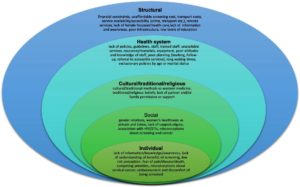
BMC Ecology and Evolution – An insight into cancer palaeobiology: does the Mesozoic neoplasm support tissue organization field theory of tumorigenesis?

Metoposaurus krasiejowensis dwelled in what we now call Poland during the Late Triassic Period around 227–216.5 years ago. Discovered in Krasiejów – the village to which it owes its name – Metoposaurus krasiejowensis is the most abundant metoposaurid amphibian from the site.
Unlike amniotes, the occurrences of cancer in anamniotes is scarcely documented. In this BMC Ecology and Evolution paper, Surmik et al., provided the first documentation of primary malignant bone tumor in a vertebra of a Mesozoic non-amniote. Gross anatomy, histology and x-ray computed micro-tomography revealed aggressive bone destruction and massive new bone formation, indicating a sarcoma of the osteosarcoma or chondrosarcoma variety. Using sections from the sample, the researchers found that the osteosarcoma penetrated deep from the surface of the bone into its interior.
The discovery of neoplasm in this ancient patient not only expands our knowledge on the ancient ancestry of cancer, but can shine light onto the pathophysiological aspects of carcinogenesis. This in turn, may aid in the development of new treatment strategies for cancer.
This publication is a part of the BMC Ecology and Evolution Collection on the “Evolutionary Biology and Ecology of Cancer”. To find out more, visit: https://www.biomedcentral.com/collections/ECEVC.
BMC Medical Ethics – Effect of medical researchers’ creative performance on scientific misconduct: a moral psychology perspective

When does being good allow us to be bad? According to the theory of moral licensing, when an individual behaves in a way they consider moral, this increases confidence in their self image. This moral confidence then ‘licenses’ them against immoral choices in the future. A simple example would be, someone indulging themselves with unhealthy food, after a period of eating healthy food. Moral licensing is a theory widely used in social psychology to explain human behavior and moral-regulation.
In an effort to better understand the influence of moral licensing on scientific misconduct, researchers from Beijing Information Science & Technology University and Hebei University of Engineering constructed a moderated mediation model. 287 medical researchers from China were recruited for the study, wherein researchers found that creative performance was positively associated with scientific misconduct. Zhang et al. argue that researchers with higher creativity are more likely to establish moral licensing, resulting in subsequent scientific misconduct. However, they also explained that participants with high levels of moral identity – the importance of morality to one’s identity – are more likely to restrain the establishment of moral licensing.
Although an individual’s characteristics can play a role in scientific misconduct, other factors such as unethical academic climate and flawed organizational systems have been shown to encourage such behaviors. A holistic approach in limiting the occurrence of misconduct in science is required. This study published in BMC Medical Ethics provides a moral psychology perspective, and practical significance for prevention of scientific misconduct in medical research institutions.
BMC Gastroenterology – Markers of immune dysregulation in response to the ageing gut: insights from aged murine gut microbiota transplants

As humans live longer, the older population grows dramatically. This shift in the population has important implications for society. Understanding the intricacies of aging is crucial, to ensure that humans can live not only longer, but also healthier lives. The proper functioning of the host-immune system is largely affected by the gut microbiome, and age-related immune system decline significantly affects the health of older people. However, genetic evidence of age-related immune changes in the gut microbiota, remains under-explored.
A recent study published in BMC Gastroenterology investigated a total of 112 differentially expressed genes (DEGs) of small intestine samples from young mice transplanted with old donor gut microbiota. Using estimations from The Cancer Genome Atlas and the Genotype-Tissue Expression project, the association between the immune-associated DEGs and the microenvironment status in the normal gut tissues were established. Giannos and co-authors identified a 25-gene signature of immune-associated DEGs. Among others, these DEGs were associated with naive T-cell, effector memory T-cell, and central memory T-cell. In the recipient mice transplanted with old gut microbiota, antigen presentation was the most down-regulated pathway. These genes may have a role as candidate markers of immune dysregulation, in the aging gut.
Disturbance in the composition and the diversity of the gut microbiota, coincides with the decline in immune homeostasis during aging. This study gives insight into the gene signatures associated with an aging gut, and the relationship between aging in the gut microbiota and immune functionality.
BMC Women’s Health – Barriers to uptake of cervical cancer screening services in low-and-middle-income countries: a systematic review
Cervical cancer is the fourth most common cancer among women globally. Almost all cervical cancer cases are linked to human papillomaviruses infection and vaccination, and screening remains a key component in elimination of cervical cancer. Due to barriers to screening uptake, low and middle income countries bear the largest burden of cervical cancer mortality. Uncovering the barriers along with implementation of measures that prioritize increased screening uptake is crucial.
In a study published in BMC Women’s Health, researchers performed a systematic review to investigate the barriers to cervical cancer screening among women in low and middle income countries. After a screening of 2148 articles, 79 studies published between 2010 and 2020 were included, with the majority of the studies undertaken in Africa. Including studies using qualitative, quantitative and mixed methods study designs, the authors identified five categories that described these barriers:
- Individual or personal barriers (including lack of knowledge, awareness and understanding of screening)
- Social barriers (including gender relations, community obstacles, misconceptions about screening and cancer)
- Cultural, traditional or religious barriers (concerns norms and expectations associated with culture and religious beliefs)
- Health system barriers (including lack of policies and services, lack of resources, and overall design, function and implementation of health systems)
- Structural barriers (including but not limited to financial constraints, unaffordable screening cost, low levels of education)
This review provides a comprehensive overview of the barriers of cervical cancer screening uptake and shows that the barriers are complex and layered. There is an urgent need to tackle the barriers from all directions, from implementation of policies supporting the sexual and reproductive health of women and girls, to addressing misconceptions prevalent in many communities. The researchers leave us with a takeaway message: “It is only in reducing the barriers to cervical cancer screening that so many women continue to face, that the aims of the WHO’s global strategy to eliminate cervical cancer as a public health problem will be fulfilled.”
BMC Medical Informatics and Decision Making – Measurement of provider fidelity to immunization guidelines: a mixed-methods study on the feasibility of documenting patient refusals of the human papillomavirus vaccine

Global HPV immunization coverage remains sub-optimal. While parental hesitancy is a known significant barrier, provider recommendation remains the strongest patient-level predictor of HPV vaccine uptake. To improve HPV vaccine uptake, further refinement of more structured electronic health records is needed. Adding a patient refusal to vaccine measure can provide a better understanding of all instances where a provider recommended vaccination, and whether it led to refusal or vaccination. However, many electronic health records are not designed to document vaccine refusals in a way that is consistent and efficient.
To improve healthcare provider performance and professional practice, audit and feedback plays an important role. In this study published in BMC Medical Informatics and Decision Making, a parent trial was done to compare coach-based versus web-based practice to increase HPV vaccination uptake in community-based pediatric practices. Secondary data analysis was then conducted to look at whether adding a patient refusal measure as a parameter can improve the electronic health records and provider fidelity in the context of human papillomavirus vaccine. The researchers reported that measuring documented vaccine refusals, together with documented vaccine administration enables a more accurate measurement of provider compliance to vaccination guidelines. Although they found mixed results when it comes to feasibility and limited adoption among the pediatric practices, they found strong use among practices that adopt the method, along with ability to identify patient demographic patterns of vaccine refusals.
Enabling a more systematic and streamlined documentation of vaccine refusals can aid in future assessment and feedback efforts by improving adherence to HPV vaccination guidelines. On top of addressing vaccine hesitancy, implementation of an efficient patient refusal documentation may aid in increased immunization coverage.

Comments